Strength training goes beyond lifting weights and involves understanding how your muscles function together in synchronization. The concept of the kinetic chain sees your body as a unified system of interconnected joints and muscles. By incorporating kinetic chain principles into your workouts, you are not just working on individual muscles but training your entire body to move efficiently, handle heavier loads, and develop significant strength. Whether your goal is strength, muscle growth, or functional fitness, prioritizing exercises that engage the kinetic chain can accelerate your progress.
The kinetic chain can be likened to a chain reaction: the movement of one joint sets off a sequence involving other joints. This connectivity means that actions at one joint have repercussions on surrounding areas like the back, hips, and knees. Rather than isolating specific muscles, focusing on these movement patterns enhances coordination, reduces the risk of injuries, and results in more substantial muscle development. Essentially, training the kinetic chain translates to building muscle mass more effectively.
Now, let’s delve into the science behind the kinetic chain and explore ten top-notch exercises that leverage this concept to promote muscle growth and strength. We will dissect what makes these exercises efficient, the muscle groups they target, and whether they fall under open or closed kinetic chain movements. Additionally, I will provide recommendations on sets and reps to kickstart your journey. Let’s get started!
What is the Kinetic Chain?

The kinetic chain refers to the body’s interconnected system of joints and muscles. When you perform a movement, your body doesn’t just use a single muscle; it recruits several muscles and joints to work together. For example, when you throw a punch, your shoulder, elbow, and wrist contribute to the motion, while your core and legs provide stability. This movement chain is why understanding and training the kinetic chain is essential for both performance and injury prevention.
When we train with the kinetic chain in mind, we target the primary muscles (like the chest or quads) and the stabilizing muscles that assist in the movement. This results in a stronger, more functional body that is less prone to injury and can handle more intense training loads over time. Training the kinetic chain also boosts your body’s ability to transfer energy from one part of your body to another, leading to more powerful movements.
Open vs. Close Kinetic Chain Exercises
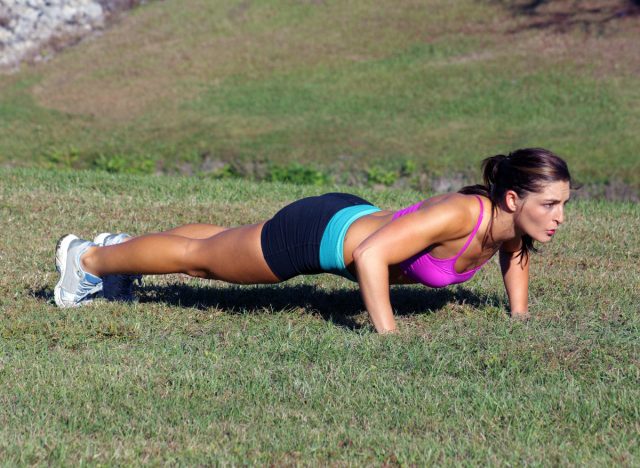
Kinetic chain exercises are categorized into two types: open and closed. Open kinetic chain exercises are movements where the hand or foot is free to move and not in contact with a surface (like a leg extension or bicep curl). These exercises tend to isolate a specific muscle or joint, making them great for targeting specific areas.
On the other hand, closed kinetic chain exercises involve movements where the hand or foot is in a fixed position, such as during a squat or pushup. These exercises require multiple joints and muscles to work together, making them more functional and effective for building strength and size.
Both open and closed kinetic chain exercises have their place in a well-rounded workout routine. Closed-chain exercises tend to be more effective for full-body strength and muscle growth, while open-chain exercises are useful for isolating and strengthening specific muscles. By incorporating both types into your training, you can maximize your gains and ensure balanced development across your entire body.
10 ‘Kinetic Chain’ Exercises To Build Stronger, Bigger Muscles
Incorporating exercises that target the kinetic chain is essential to build a solid foundation and achieve substantial muscle growth. The kinetic chain includes the interconnected muscles and joints that work together to perform movement. By focusing on exercises that enhance this system, you’ll develop stronger, bigger muscles and improve overall functional strength and stability.
This section will explore 10 powerful kinetic chain exercises carefully chosen to maximize muscle engagement and growth. These exercises will help you build a well-rounded, powerful physique, from the foundational squat to dynamic medicine ball slams.
Exercise #1: Squats (Close Chain)
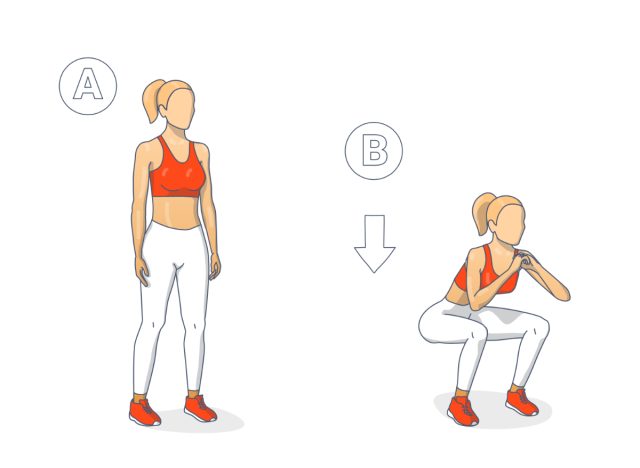
The squat is a powerhouse for building lower-body strength and muscle mass. It engages multiple muscle groups simultaneously, including the quads, hamstrings, glutes, and core, making it a fundamental exercise for overall leg development and functional strength. Squats enhance your lower-body muscle size, improve your ability to handle heavier weights, and stabilize your core.
- Begin by standing with your feet shoulder-width apart and your toes slightly pointed out.
- Hold the barbell across your upper back, gripping it slightly wider than shoulder-width.
- Brace your core, push your hips back, and bend your knees to lower your body as if sitting in a chair.
- Keep your chest up and back straight throughout the movement.
- Lower down until your thighs are parallel to the ground or slightly below.
- Push through your heels to return to the starting position, fully extending your hips and knees at the top.
- Ensure your knees track in line with your toes and avoid letting them cave inward.
- Perform four sets of 8 to 12 reps with moderate to heavy weight. Rest for 90 seconds between sets.
Exercise #2: Deadlift (Close Chain)
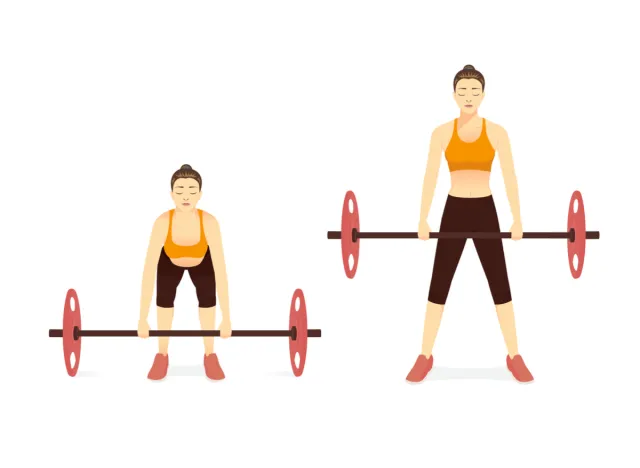
The deadlift is a comprehensive full-body exercise that primarily targets the posterior chain, including the hamstrings, glutes, and lower back. It also engages the traps and core, making it excellent for developing strength and muscle mass across several key muscle groups. Deadlifts help improve your posture, balance, and overall power by requiring coordinated effort from multiple muscles and joints.
- Stand with your feet hip-width apart and the barbell positioned over the middle of your feet.
- Bend at the hips and knees to grasp the bar with an overhand grip, keeping your back flat and chest up.
- Drive through your heels, extend your hips and knees simultaneously to lift the barbell, and keep it close to your body throughout the movement.
- Once you reach a fully extended position, reverse the movement by pushing your hips back and bending your knees to lower the barbell back to the ground.
- Maintain a neutral spine and engage your core throughout the lift.
- Complete four sets of 6 to 8 reps with moderate-heavy weight. Rest for 120 seconds between sets.
Exercise #3: Bench Press (Open Chain)
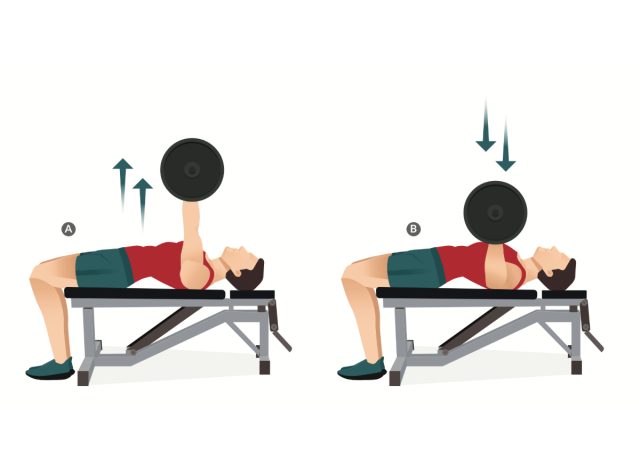
The bench press is an effective exercise for building upper-body pushing strength and chest size. It primarily targets the chest, shoulders, and triceps and is a staple in developing upper-body muscle mass. Focusing on the bench press can enhance your pressing power and improve overall upper body aesthetics and strength.
- Lie flat on a bench with your feet firmly planted on the ground.
- Grip the barbell with your hands slightly wider than shoulder-width apart.
- Lift the barbell off the rack and lower it slowly to your chest, keeping your elbows at about a 45-degree angle from your body.
- Push the barbell back up to the starting position, fully extending your arms.
- Maintain a stable core and avoid arching your lower back excessively during the press.
- Keep your shoulder blades retracted and your chest up throughout the movement.
- Knock out four sets of 8 to 10 reps with moderate to heavy weight. Rest for 90 seconds between sets.
Exercise #4: Pull-up (Close Chain)
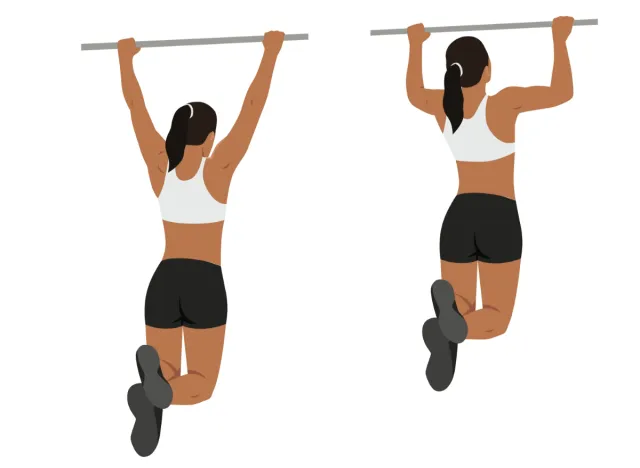
Pull-ups are a highly effective bodyweight exercise that enhances upper-body pulling strength and muscle development. It primarily works the lats, biceps, shoulders, and core and requires significant upper-body strength and endurance. By incorporating pull-ups into your routine, you can achieve better upper body definition and strength.
- Hang onto a pull-up bar with your hands slightly wider than shoulder-width apart and your palms facing away.
- Engage your core and pull your body up until your chin is above the bar, squeezing your shoulder blades together at the top.
- Lower yourself back down in a controlled manner until your arms extend fully.
- Avoid swinging or using momentum to complete the movement, and focus on using your back and arms to perform the pull-up.
- Complete four sets of 6 to 10 reps (add weight if possible). Rest for 90 seconds between sets.
Exercise #5: Overhead Press (Open Chain)
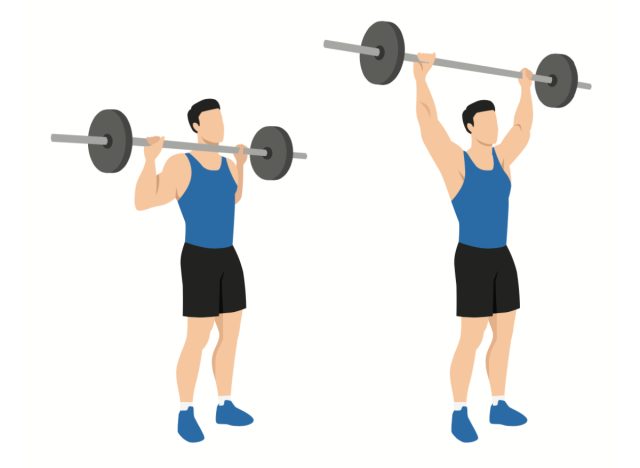
The overhead press is crucial for building shoulder and upper-body pressing strength. It targets the shoulders, triceps, and upper chest while engaging the core for stability. This exercise improves shoulder strength, pressing power, and overall upper-body muscle size.
- Stand with your feet shoulder-width apart and grasp the barbell with an overhand grip, hands slightly wider than shoulder-width.
- Begin with the barbell resting on your shoulders, elbows bent and slightly in front of the bar.
- Press the barbell overhead, extending your arms fully while keeping your core tight and your back straight.
- Lower the barbell back down to your shoulders with control.
- Avoid arching your lower back and ensure your movements are smooth and steady.
- Perform four sets of 8 to 10 reps with moderate weight. Rest for 60 seconds between sets.
Exercise #6: Lunges (Close Chain)
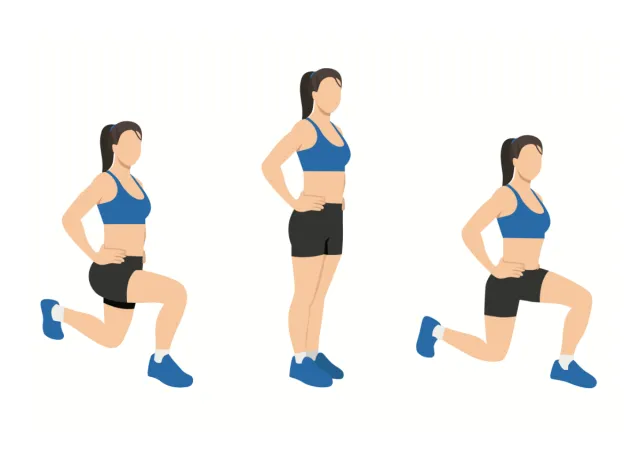
Lunges are fantastic for improving lower-body strength, stability, and balance. They primarily work the quads, hamstrings, glutes, and calves, offering a well-rounded approach to lower body development. Lunges also help enhance unilateral strength and coordination, which is beneficial for athletic performance and functional movements.
- Stand upright with feet hip-width apart.
- Step forward with one leg and lower your body until your front thigh is parallel to the ground and your back knee nearly touches the floor.
- Keep your torso upright and your front knee aligned with your toes.
- Push through your front heel to return to the starting position, and repeat with the opposite leg.
- Ensure that each lunge is performed with controlled movements and proper alignment to maximize effectiveness and prevent injury.
- Knock out three sets of 10 to 12 reps per leg. Rest for 90 seconds between sets.
Exercise #7: Lat Pulldown (Open Chain)
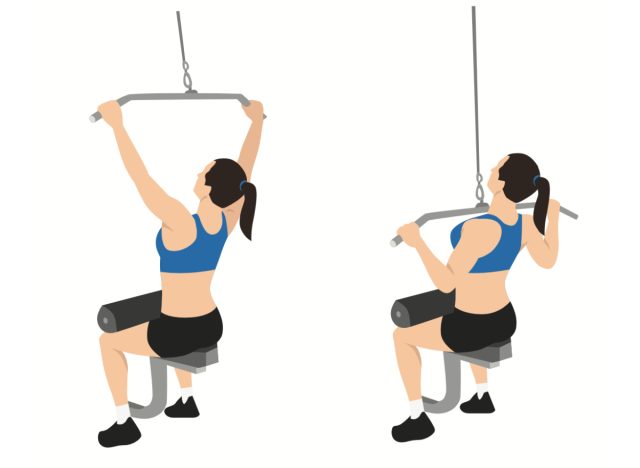
The lat pulldown effectively targets the upper-back muscles, particularly the lats, biceps, and shoulders. It improves pulling strength and develops a wider, more defined back. Incorporating lat pulldowns into your routine can enhance upper-body strength and achieve better muscular balance.
- Sit at the lat pulldown machine with your knees secured under the pads.
- Grasp the bar with a wide overhand grip and pull it down toward your chest while leaning slightly back.
- Engage your back muscles and squeeze your shoulder blades together as you pull the bar down.
- Slowly return the bar to the starting position, allowing your arms to extend while maintaining complete control throughout the movement.
- Avoid using momentum or excessive swinging to complete the exercise.
- Complete four sets of 10 to 12 reps with moderate weight. Rest for 60 seconds between sets.
Exercise #8: Barbell Row (Open Chain)
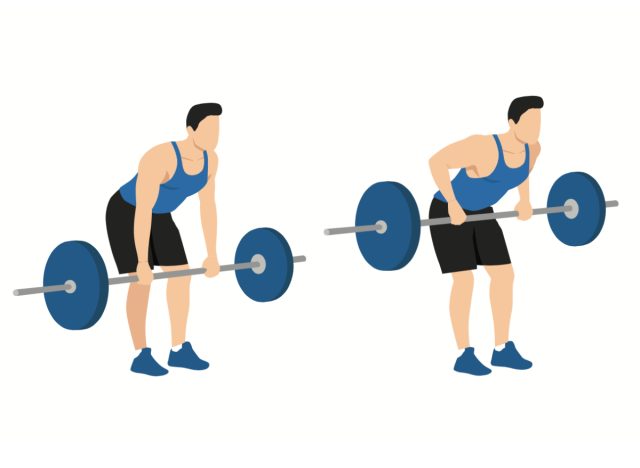
The barbell row is powerful for developing upper back strength and muscle mass. It targets the lats, rhomboids, traps, and rear deltoids, enhancing overall back thickness and improving posture. You can achieve a more muscular and balanced upper body by incorporating barbell rows.
- Stand with your feet hip-width apart and hold a barbell with an overhand grip.
- Bend your knees slightly and hinge at the hips, keeping your back flat and chest up.
- Pull the barbell toward your lower ribcage, squeezing your shoulder blades together at the top.
- Lower the barbell back down in a controlled manner until your arms are extended fully.
- Avoid rounding your back or using excessive momentum during the lift.
- Perform four sets of 12 to 15 reps. Rest for 60 to 90 seconds between sets.
Exercise #9: Leg Press (Open Chain)
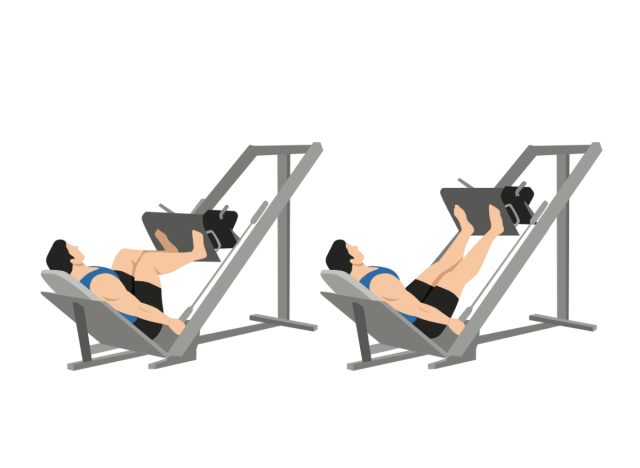
The leg press is an excellent exercise for targeting the quads, hamstrings, glutes, and calves, focusing on overall lower-body strength and hypertrophy. It allows for heavy loading of the lower-body muscles while providing stability and support to the back and core. The leg press is ideal for building leg size and strength in a controlled manner.
- Sit on the leg press machine with your back supported and your feet placed shoulder-width apart on the platform.
- Extend your legs to push the platform away from you, keeping a slight bend in your knees.
- Lower the platform slowly by bending your knees until your thighs are nearly parallel.
- Push through your heels to return to the starting position.
- Maintain a controlled pace and avoid locking your knees at the movement’s top.
- Knock out four sets of 10 to 12 reps with heavy weight. Rest for 90 to 120 seconds between sets.
Exercise #10: Medicine Ball Slams (Close Chain)
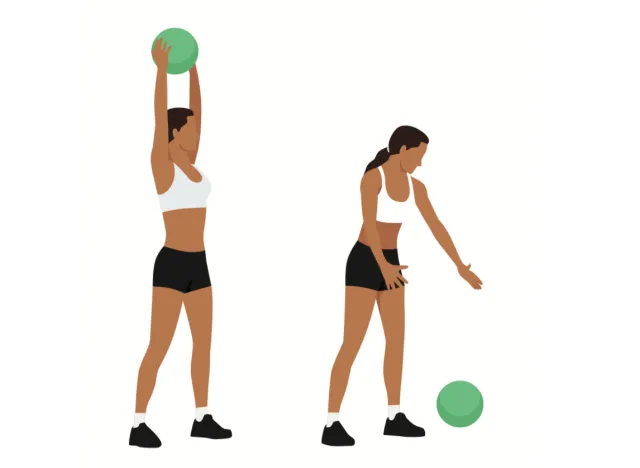
Medicine ball slams are dynamic exercises that combine strength and power and target the entire body. They engage the core, shoulders, and legs, improving explosive power and athleticism. This exercise effectively enhances conditioning, functional strength, and muscular endurance.
- Stand with your feet shoulder-width apart and hold a medicine ball overhead with both hands.
- Engage your core and slam the ball onto the ground as hard as possible, using your entire body to generate force.
- Squat down to pick up the ball and repeat the slam.
- Focus on maintaining a solid core and explosive movement throughout the exercise.
- Keep your movements controlled and avoid hyperextending your lower back.
- Complete three sets of 10 to 12 reps. Rest for 60 seconds between sets.
Frequently Asked Questions (FAQs) About Kinetic Chain Exercises for Building Muscle
What are kinetic chain exercises?
Kinetic chain exercises are multi-joint movements that involve multiple muscles and joints working together in a coordinated manner. These exercises are also known as compound exercises and are more functional in nature, as they mimic real-life movements and engage more muscle groups compared to isolation exercises.
Why are kinetic chain exercises beneficial for building muscle?
Kinetic chain exercises are beneficial for building muscle because they allow you to lift heavier weights and engage multiple muscle groups in one movement. This leads to increased muscle activation and growth compared to isolation exercises, which target only one muscle group at a time.
What are some examples of kinetic chain exercises?
- Deadlifts: This exercise targets the hamstrings, glutes, lower back, and forearms.
- Squats: Squats work the quadriceps, hamstrings, glutes, and core muscles.
- Bench Press: The bench press engages the chest, shoulders, and triceps.
- Pull-Ups: Pull-ups target the back, biceps, and shoulders.
- Push-Ups: Push-ups work the chest, shoulders, triceps, and core muscles.
How can I incorporate kinetic chain exercises into my workout routine?
You can incorporate kinetic chain exercises into your workout routine by including them in your strength training sessions. Aim to perform compound exercises like squats, deadlifts, and bench press at least 2-3 times a week, focusing on proper form and gradually increasing the weight lifted to stimulate muscle growth.
Are kinetic chain exercises suitable for all fitness levels?
Kinetic chain exercises can be modified to suit individuals of all fitness levels. Beginners may start with bodyweight exercises like squats and push-ups to build a foundation of strength before progressing to using weights. It’s essential to consult with a fitness professional to ensure proper form and technique to prevent injuries.






